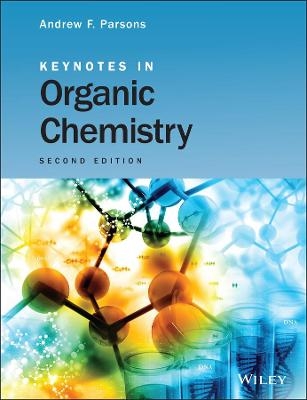
Keynotes in Organic Chemistry
John Wiley & Sons Inc (Verlag)
978-1-119-99914-0 (ISBN)
KEYNOTES IN Organic Chemistry KEYNOTES IN Organic Chemistry
SECOND EDITION
This concise and accessible textbook provides notes for students studying chemistry and related courses at undergraduate level, covering core organic chemistry in a format ideal for learning and rapid revision. The material, with an emphasis on pictorial presentation, is organised to provide an overview of the essentials of functional group chemistry and reactivity, leading the student to a solid understanding of the basics of organic chemistry.
This revised and updated second edition of Keynotes in Organic Chemistry includes:
new margin notes to emphasise links between different topics,
colour diagrams to clarify aspects of reaction mechanisms and illustrate key points, and
a new keyword glossary.
In addition, the structured presentation provides an invaluable framework to facilitate the rapid learning, understanding and recall of critical concepts, facts and definitions. Worked examples and questions are included at the end of each chapter to test the reader’s understanding.
Reviews of the First Edition
“ …this text provides an outline of what should be known and understood, including fundamental concepts and mechanisms.”
Journal of Chemical Education, 2004
“ Despite the book’s small size, each chapter is thorough, with coverage of all important reactions found at first-year level... ideal for the first-year student wishing to revise… and priced and designed appropriately.”
The Times Higher Education Supplement, 2004
Andrew F. Parsons Department of Chemistry, University of York, UK
Preface xi
1 Structure and bonding 1
1.1 Ionic versus covalent bonds 1
1.2 The octet rule 2
1.3 Formal charge 2
1.4 Sigma and pi bonds 3
1.5 Hybridisation 4
1.6 Inductive effects, hyperconjugation and mesomeric effects 6
1.7 Acidity and basicity 9
2 Functional groups, nomenclature and drawing organic compounds 21
2.1 Functional groups 21
2.2 Alkyl and aryl groups 22
2.3 Alkyl substitution 23
2.4 Naming carbon chains 23
2.5 Drawing organic structures 27
3 Stereochemistry 31
3.1 Isomerism 31
3.2 Conformational isomers 32
3.3 Configurational isomers 37
4 Reactivity and mechanism 49
4.1 Reactive intermediates: ions versus radicals 49
4.2 Nucleophiles and electrophiles 51
4.3 Carbocations, carbanions and carbon radicals 53
4.4 Steric effects 55
4.5 Oxidation levels 55
4.6 General types of reaction 56
4.7 Ions versus radicals 59
4.8 Reaction selectivity 60
4.9 Reaction thermodynamics and kinetics 60
4.10 Orbital overlap and energy 65
4.11 Guidelines for drawing reaction mechanisms 67
5 Halogenoalkanes 73
5.1 Structure 73
5.2 Preparation 74
5.3 Reactions 78
6 Alkenes and alkynes 95
6.1 Structure 95
6.2 Alkenes 97
6.3 Alkynes 110
7 Benzenes 117
7.1 Structure 117
7.2 Reactions 119
7.3 Reactivity of substituted benzenes 123
7.4 Nucleophilic aromatic substitution (the SNAr mechanism) 127
7.5 The formation of benzyne 128
7.6 Transformation of side chains 129
7.7 Reduction of the benzene ring 132
7.8 The synthesis of substituted benzenes 132
7.9 Electrophilic substitution of naphthalene 135
7.10 Electrophilic substitution of pyridine 135
7.11 Electrophilic substitution of pyrrole, furan and thiophene 136
8 Carbonyl compounds: aldehydes and ketones 139
8.1 Structure 139
8.2 Reactivity 140
8.3 Nucleophilic addition reactions 142
8.4 a-Substitution reactions 156
8.5 Carbonyl-carbonyl condensation reactions 160
9 Carbonyl compounds: carboxylic acids and derivatives 167
9.1 Structure 167
9.2 Reactivity 168
9.3 Nucleophilic acyl substitution reactions 168
9.4 Nucleophilic substitution reactions of carboxylic acids 170
9.5 Nucleophilic substitution reactions of acid chlorides 171
9.6 Nucleophilic substitution reactions of acid anhydrides 172
9.7 Nucleophilic substitution reactions of esters 173
9.8 Nucleophilic substitution and reduction reactions of amides 175
9.9 Nucleophilic addition reactions of nitriles 176
9.10 a-Substitution reactions of carboxylic acids 178
9.11 Carbonyl-carbonyl condensation reactions 178
10 Spectroscopy 185
10.1 Mass spectrometry (MS) 185
10.2 The electromagnetic spectrum 189
10.3 Ultraviolet (UV) spectroscopy 190
10.4 Infrared (IR) spectroscopy 192
10.5 Nuclear magnetic resonance (NMR) spectroscopy 194
11 Natural products and synthetic polymers 207
11.1 Carbohydrates 207
11.2 Lipids 209
11.3 Amino acids, peptides and proteins 211
11.4 Nucleic acids 213
11.5 Synthetic polymers 214
Worked example 218
Problems 219
Appendix 1: Bond dissociation enthalpies 221
Appendix 2: Bond lengths 223
Appendix 3: Approximate pKa values (relative to water) 225
Appendix 4: Useful abbreviations 227
Appendix 5: Infrared absorptions 229
Appendix 6: Approximate NMR chemical shifts 231
Appendix 7: Reaction summaries 235
Appendix 8: Glossary 241
Further reading 249
Outline answers 251
Index 277
| Erscheint lt. Verlag | 31.12.2013 |
|---|---|
| Verlagsort | New York |
| Sprache | englisch |
| Maße | 191 x 247 mm |
| Gewicht | 594 g |
| Themenwelt | Naturwissenschaften ► Chemie ► Organische Chemie |
| ISBN-10 | 1-119-99914-6 / 1119999146 |
| ISBN-13 | 978-1-119-99914-0 / 9781119999140 |
| Zustand | Neuware |
| Haben Sie eine Frage zum Produkt? |
aus dem Bereich


